Metabolic Processes
Energy In the Cell
Energy- the ^^ability to work or cause change^^ (chemical reactions)
There are 2 types:
- Potential Energy(Ep)
^^Energy stored^^, causes change in the ^^future^^.
- Kinetic Energy (Ek)
^^Energy of motion^^ causing change ^^now^^.
Free Energy(G)- ^^energy that is converted into a useful form^^ (released OR stored). ^^Available energy^^ in a system.
Entropy(S)- ^^energy that is lost as non-useful heat^^
Enthalpy(H)- ^^total energy^^ in a system
1st Law of Thermodynamics:
^^Energy cannot be created or destroyed, only converted^^ from one form to another.
2nd Law of Thermodynamics:
^^Energy is loss during transformation^^. As energy is converted, entropy increases until no energy is left to do work.
Bioenergetics- the ^^study of energy transfer^^ in the cell
- Cell Respiration
- Photosynthesis
2 Types of Metabolism
- Catabolism
Degradation/^^breakdown of biological molecules so energy is released.^^ Therefore it is ^^exergonic^^ and tend to be ^^oxidation^^. Eg. Cell Respiration.
- Anabolism
The ^^build up of biological molecules so energy is stored^^. Therefore it is ^^endergonic^^ and tends to be ^^reduction^^. Eg. Photosynthesis.
Energy Input is needed for Anabolism.
Simple Oxidation - a ^^one step chemical reaction that requires high temperature and releases large amounts of heat.^^
Body Cells cannot do simply oxidation.
^^Body cells use oxidative phosphorylation^^. It is a controlled oxidation. A ^^series of reactions.^^
Cell Respiration
Main goals:
- Break 6C glucose into a 6CO2
- More hydrogen to form 6H2O
- Trap free energy to form ATP
Cell Respiration occurs in 25-30 steps.
It occurs in 4 steps:
- Glycolysis
- Pyruvate Oxidation
- Krebs Cycle
- Electron Transport Chain and chemiosmosis
STAGE 1: GLYCOLYSIS
Where? In the ^^cytoplasm^^.
What does it start with? ^^Glucose^^
What does it produce?
- ^^2 pyruvates(Krebs)^^
- ^^2 NADH(ETC)^^
- ^^4 ATP (^^2 used, 2 left^^)^^
Summary of Glycolysis:
^^2 ATP used to prepare 6C glucose for splitting into two 3C^^ molecules. Substrate level phosphorylation is used.
^^6C glucose splits into two 3C molecules.^^
^^G3P is oxidated. It releases H+ and e- which are captured by NAD+→NADH^^. NADH moves on to the ETC.
^^ATP is produced by removing the phosphates and producing 2 pyruvates (3C).^^
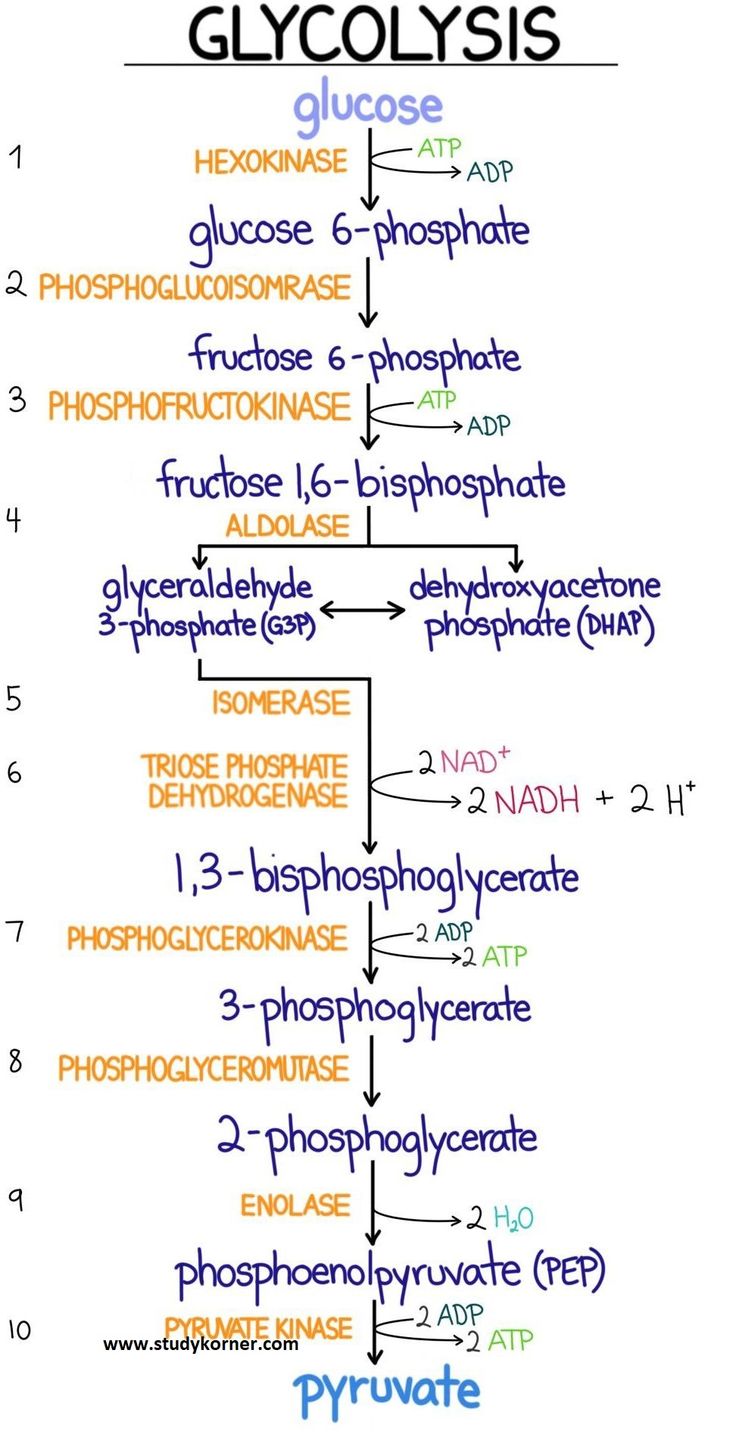
STAGE 2: PYRUVATE OXIDATION
Where? In the ^^matrix of the mitochondria.^^
What does it start with? ^^2 pyruvates^^.
What does it produce?(per cycle)
- ^^1 Acetyl CoA^^
- ^^1 CO2^^
- ^^1 NADH^^
Summary of Pyruvate Oxidation:
^^Pyruvate enters the mitochondria^^ from the cytoplasm.
^^One carbon is removed with a release of CO2.^^
^^Hydrogen is removed by NAD+→NADH.^^
^^A CoA (coenzyme) becomes attached^^ to the remaining carbons which ^^creates Acetyl CoA.^^

STAGE 3: KREBS CYCLE
Where? In the ^^matrix of the mitochondria.^^
What does it start with? ^^Oxoloacetate (OAA) and Acetyl CoA^^
What does it produce? (Per cycle)
- ^^2 CO2^^
- ^^2 CoA^^
- ^^3 NADH^^
- ^^1 FADH^^
- ^^1 ATP^^
Summary of Krebs Cycle:
An ^^Acetyl CoA(2C) molecule joins a Oxaloacetate(4C) molecule to produce Citrate(6C).^^
^^Isocitrate(6C) is oxidized into an Alpha-ketogluterate(5C) and then into Succenyl CoA(4C)^^ while ^^producing 2 NADH and 2 CO2.^^ All original carbons have been released at this point.
^^Succenyl CoA(4C) is converted into succinate(4C) while producing an ATP and losing a CoA.^^
^^Succinate(4C) converts to Fumerate(4C) and makes FADH2^^
^^Fumerate(4C) is converted into Malate(4C) and then is converted back into Oxaloacetate(4C) while producing NADH.^^

STAGE 4: ÉLECTRON TRANSPORT CHAIN AND CHEMIOSMOSIS
Where? In the ^^cristae folds, the matrix and the inner membrane space of the mitochondria.^^
What does it start with? ^^NADH and FADH^^
What does it produce? ^^36-38 ATP^^
Summary of the ETC+C:
^^NADH is oxidized in the matrix. High energy e- are released into the ETC.^^
^^e- from NADH moves down ETC and use energy to pump H+ ions across the membrane^^. (3 pumps)
After the third pump the ^^e- is accepted by oxygen to form H2O.^^ This ^^allows for more e- to flow^^ down the chain.
(CHEMIOSMOSIS).The ^^high [H+] in the inner membrane are moved through ATP synthesis back into the matrix, low [H+]. This movement creates the energy needed to form ATP from ADP and Pi.^^
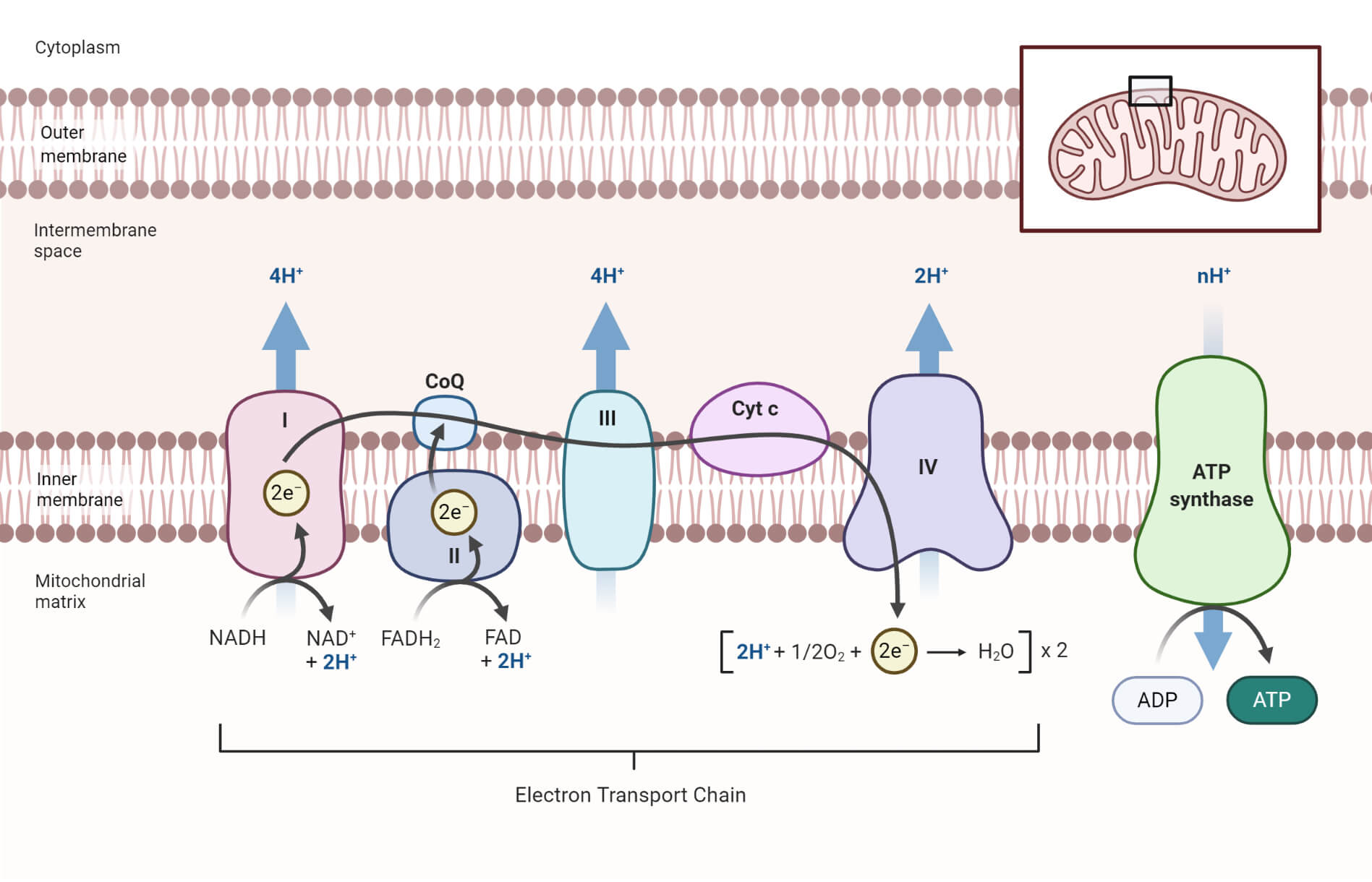
Note: FADH produces 2 ATP because it only goes through 3 pumps whereas NADH produces 3 because it travels through all 3 pumps.
Summary of C.R
Remember: NADH creates 3ATP, FADH creates 4ATP
ATP YEILD
Glycolysis:
- -2 for activation
- +4 from substrate phosphorylation
- +4-6 (2NADH) from ETC (G3P→BPG)
^^Total: 6-8 ATP^^
Pyruvate and Krebs Cycle:
- +6 (2NADH) from Pyruvate→ Acetyl CoA
- +6 (2NADH) Isocitric→Alpha-Ketoglutaric
- +6 (2NADH) Alpha-Ketoglutaric→ Succinyl CoA
- +2 Succinyl CoA → Succinate
- +4 (2FADH) Succinate→Fumarate
- +6 (2NADH) Malate → Oxaloacetate
^^Total: 30 ATP^^
Cellular respiration total ATP: 36-38 ATP
What do we use the ATP for?
^^ATP is used immediately^^ to do things like; ^^make protein, muscle fibrils contractions, DNA+RNA assembly, nerve impulse trahissions, active transport and chemical reaction activation.^^
The Final Equation:
C6H12O6 + 6O2 + 6H2O → 6CO2 + 12H2O + 36-38 ATP + Heat
- ^^6O2 supplies 12O- at ETC^^
- ^^6H2O from krebs^^
- ^^6Co2 from pyruvates^^
- ^^24H+ and 24e- from NADH and FADH2^^
- ^^24H + 12O- → 12H2O at the end of ETC.^^
Fermentation (C.R)
What happens when no O2 is present?
- ^^No O2= no final e- acceptor^^
- ^^E- cannot move through 3rd pump (ETC)^^
- No e- from carrier #2. Therefore ^^no e- movement in ETC, no [H] gradient, no ATP^^
- ^^Prevent oxidation of NADH and FADH2^^ which limits reaction due to NAD+ and FAD not being available.
Alcohol fermentation in yeast
- the reduction of acetaldehyde into enthalpy allows the oxidation of NADH→NAD+
- The NAD+ produced is used in glycolysis, produces minimal ATP.
Lactic acid fermentation in muscle cells:
- reduce pyruvate to make lactic acid. Therefore NAD+ becomes available, glycolysis can continue.
Alternative Pathways (C.R)
Energy from proteins:
Eg. Alanine (amino acid)
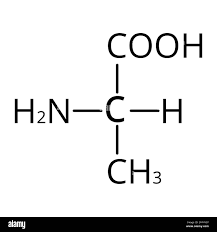
- proteins must be digested into amino acids.
- The amino group is removed, this is called “deamination” and occurs in the liver.
- The amino group is converted into urea(urine) and is excreted.
- The carbon chain that you are left with is inserted into C.R pathway as pyruvate.
- 1 molecule of Alanine creates 15ATP
Energy from fats:
Eg. Triglycerides
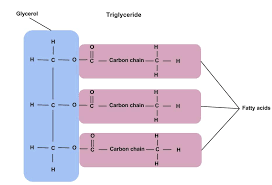
- Digested into fatty acids and glycerol.
- Glycerol goes into C.R pathway
- F.A are broken down for entry into pathway by using B-Oxidation.
- F.A are broken into 2C subunits
- Each cut made produces 5 ATP (1NADH, 1FADH)
- 2C carbons enter C.R as Acetyl CoA
- 6C F.A can produce 44ATP
How does 6C F.A produce 44ATP?
- 2 cuts =10ATP
- 1 Acetyl CoA: 3NADH, 1FADH and 1ATP = 12ATP. 12ATP x 3 (due to 3 Acetyl CoAs) = 36 ATP
- 36+10=46 ATP
- But remember you need 2 ATP to commence the breakdown of glucose in glycolysis
- Therefore: 46-2=44
- 44 ATP
Photosynthesis
Overall Results:
- %%Anabolic%% process(put things together)
- %%Chloroplast%%(site of photosynthesis)
- %%Light energy converted into chemical energy%% (potential energy)
- %%Enzymes and intermediate molecules%% to complete process
Light is converted into glucose in approximately 2 minutes after the leaf is exposed to light.
6CO2 + 12H2O → light → C6H12O6 + 6O2 + 6H2O
Co2: in through %%stomata%% (gas exchange)
H2O: %%roots, xylem%% (water transport cells)
Glucose: %%CO2 combined H+%% ions from water
O2: from %%water%%
Chloroplast(PS)
Thylakoid: %%pigment molecules in bilayer. Traps light.%%
Stroma: %%enzymes for making glucose%%. %%Ribosomes for making proteins/enzymes. DNA that can duplicate on their own.%%
Thylakoid Membrane:
- %%traps light.%%
- Composed of a %%phospholipid bilayer.%%
- %%Protein pigment complex%%→proteins and pigment molecules embedded in the membrane that %%trap various wave lengths of light.%%
- Main pigment in plants is green due to chlorophyll(absorbs all but green light).
- Other pigment→carotenoids, xanthophylls (absorb different wave lengths)
Photosystem:
- %%Groups of 40-500 pigment protein molecules in the thylakoid membrane.%%
- %%Absorbs various wavelengths to make glucose.%%
- Half the molecules are chlorophyll, other half are pigment molecules called Accessory Pigments.
Chlorophyll:
- %%Primary light absorber.%%
- %%Porphyrin ring Containing Mg atom%%→similar to the heme ring structure of hemoglobin and cytochromes except they contain Fe.
- %%Long hydrocarbon tail called the phytol tail.%%
%%Both A and B chlorophyll are embedded in the thylakoid bilipid layer by the phytol tail%% being buried inside. The %%phytol tail is hydrophobic and the porphyrin ring is hydrophilic.%%
Both types absorb red and blue-violet light, they reflect green wavelengths.
%%Many double bonds alternate with single bonds. This allows the molecules to absorb light.%% It %%allows extra electrons of the double bonds to be excited%% when light photons hit them. This %%occurs in the porphyrin ring.%%
Chlorophyll A:
- %%Contains a CH3%% group
- Absorbs more %%violet light%%
- %%Main trap pigment. Only it can pass light energy onto another molecule that can store it as potential energy.%%
Chlorophyll B:
- %%Contains aldehyde%% group
- Absorbs more %%blue wavelengths%%
- Is an %%accessory%% pigment
- %%Absorbs light and passes it on to Chlorophyll A.%%
There is normally 3x more chlorophyll A than B.
Light Reactions (PS)
- Light dependant reactions
- %%light energy strikes the chlorophyll.%%
- Occurs in the %%thylakoid membrane.%%
- Involve %%photosynthesis%%→groups of chlorophyll molecules and accessory pigments.
- Use %%light energy to excite e- and create ATP and NADPH%% to power the production of glucose.
- Light independent reactions
- %%Calvin cycle%%
- Occurs in the %%stroma%% of chloroplast.
- Involves a series of steps that %%combines CO2 into a glucose molecules.%% It %%uses ATP and NADPH from light dependant reactions.%%
Light dependant summary:
- %%Light strikes PS2 and excited e-%% in pigment molecules.
- %%Excited e- are ejected from chlorophyll A to plastoquinone%% (e carrier).
- %%PQ moves e- to the B6F%% complex which %%pulls H+ across the membrane.%%
- %%e- move from B6F complex to plastocyanin%% (e carrier) and %%into PS1.%%
- The %%H+ ions are moved through ATP synthase to create ATP.%%
- %%E- lost from PS2 are replaced when Z enzyme splits water%%, releasing H+, O and e-.
- %%PS1 absorbs light energy e- are excited.%%
- %%e- move to ferredoxin%% (e carrier) %%then to NADP reductase%%. E- are %%used to reduce NADP to NADPH.%%
- %%E- from PS2 replenish e- lost in PS1%%
- %%ATP and NADPH move to the Calvin cycle%% to produce glucose.
Calvin Cycle summary:
- Carbon Fixation
- %%CO2 is fixed to RuBP and produces 3PG%%. Rubisco is the enzyme needed for this reaction.
- Reduction
- %%3PG is reduced using ATP from light reactions to produce 1,3BPG.%%
- %%1,3BPG is reduced using NADPH from light reaction to produce G3P.%%
- Some G3P is released from the cycle to make glucose.
- Regeneration
- %%Most G3P will react with ATP to regenerate the RuBP%% molecules the cycles started with.
Cyclic and NonClycic(PS)
Noncyclic: electron flow generates a proton gradient for chemiosmotic ATP synthesis and NADPH. Normal light reaction.
Cyclic: e- excited in PS1 are taken back to the B6F complex by ferridoxin to pump H+ ions across the membrane. These ions can then be used to make ATP. PC recycles the e- back to PS1 and the cycle can continue.
The Leaf and Photorespiration (PS)
Light energy transfers through the upper cuticle.
H2O transported by veins.
CO2 enters through lower cuticle/stomata
O2 leaves through lower cuticle/stomata
H2O(some) diffuses through lower cuticle/stomata
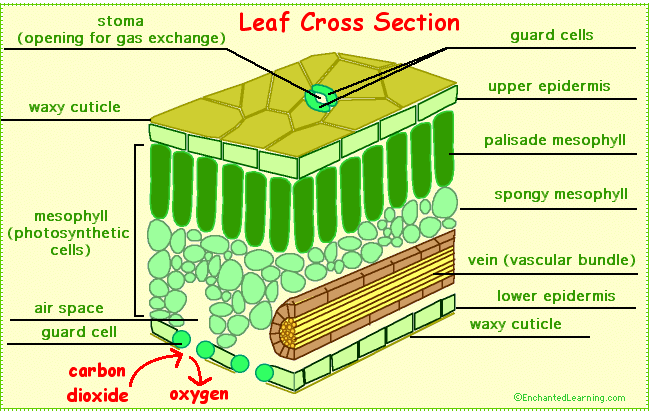
Photorespiration
- on hot days the stomata will close to help preserve H2O. That causes [CO2] to decrease and [O2] to increase.
- Rubisco likes CO2 when its present but will react with O2 if CO2 levels drop.
- When Rubisco reacts with O2 it creates a set of reactions that results in CO2 being released.
- Some plants lose up to 50% of their fixed carbon during Photorespiration.
- \
Alternative Pathways (PS)
C3, normal plants.
C4 Pathway (Hot/dry/tropical)
Uses Z locations
- Mesophyll cells (photosynthetic cells)
- Bundle Sheath Cells (area for Calvin cycle)
uses special enzymes that only reacts with CO2. Pepcarboxylose.
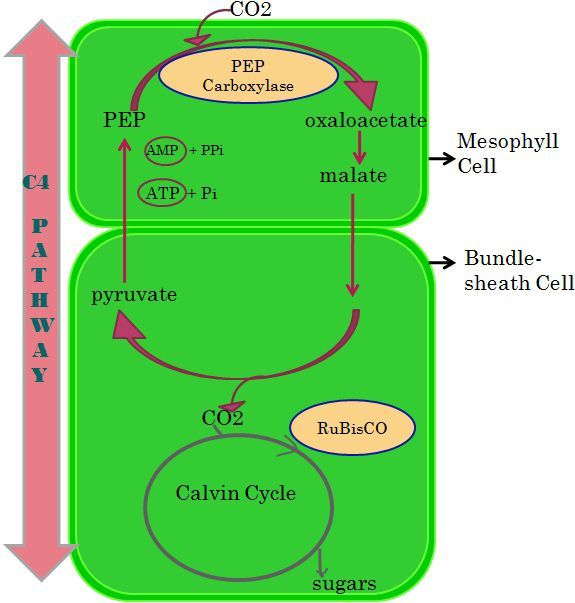
CAM plants (cactus)
Uses different times of day.
At night, the stomata opens, CO2 diffuses into plant.
During the day, stomata closes and light reactions occur and create energy for Calvin cycle.

Factors affecting photosynthesis (PS)
- Light intensity
- Light wavelength
- Tempurature
- [CO2]
- [O2]
- Plant type
How can we measure the rate of photosynthesis?
Net CO2 uptake= CO2 taken in during photosynthesis - CO2 released during during mito respiration - CO2 released into a plant during photorespiration.
Bibliography
The Leaf and Photosynthesis
Anatomy of a leaf diagram. https://www.enchantedlearning.com/subjects/plants/leaf/
Alternative Pathways
C4 pathway diagram. https://biodifferences.com/difference-between-c3-c4-and-cam-pathway.html
CAM pathway diagram. https://www.botanicacuriosa.com/blog/crassulacean-acid-metabolism-cam-the-other-photosynthesis